 Women who spend most of the day standing at the counter or, conversely, lead a sedentary lifestyle, are well aware of the problem of the formation of vascular networks on the legs, which over time can develop into a serious vein pathology - varicose veins. Varicose veins can also develop in pregnant women during the gestational period and during childbirth. A phenomenon such as thrombosis in a patient is observed during any surgical interventions due to the fact that in response to an incision made with a scalpel, the blood begins to clot faster.
Women who spend most of the day standing at the counter or, conversely, lead a sedentary lifestyle, are well aware of the problem of the formation of vascular networks on the legs, which over time can develop into a serious vein pathology - varicose veins. Varicose veins can also develop in pregnant women during the gestational period and during childbirth. A phenomenon such as thrombosis in a patient is observed during any surgical interventions due to the fact that in response to an incision made with a scalpel, the blood begins to clot faster.
Constant or periodic wearing of compression stockings helps to avoid each of the above situations. Therapeutic and prophylactic products made from medical stretch knitwear have replaced elastic bandages that are inconvenient to use. Since compression stockings are worn exclusively for therapeutic and health purposes, their size must completely match the patient’s parameters.
Current sizes of compression stockings
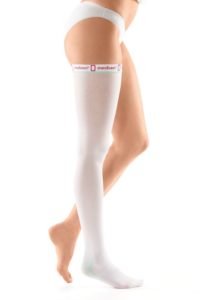
Increasingly, the list of medical supplies required for childbirth or planned surgery includes compression stockings. This is explained by the special influence of compressive knitwear on the veins, which consists in distributing pressure from bottom to top. In the hip area it is minimal, the knee receives an average load, the ankle and shin receive the maximum load that is placed on the legs while running or playing other sports.
Compression products are used to treat and prevent varicose veins because they:
- do not have seams that cause discomfort;
- very elastic;
- do not cause allergies;
- allow air to pass through well;
- have a formed foot;
- Provide pressure in the right parts of the legs.
In addition to the prevention and treatment of varicose veins and thrombosis, compression stockings can be worn by people:
- those who feel constant fatigue in their legs (hairdressers working on an assembly line);
- those suffering from edema;
- those who are prone to being overweight and overweight;
- having a genetic predisposition to vascular diseases.
Before you find out what sizes of medical compression stockings exist, you need to familiarize yourself with their types. There are four main types of therapeutic compression garments:
- Preventive. They are recommended to be worn by pregnant women, athletes and people leading a sedentary lifestyle. Prophylactic stockings normalize blood pressure in the veins and arteries, relieve fatigue and prevent swelling.
- With first class compression. Used to treat the initial stage of varicose veins, which manifests itself as a small vascular network on the thighs and calves.
- With second class compression. Used for the treatment of progressive thrombophlebitis and varicose veins.
- With third class compression.Such stockings are worn only on the recommendation of the attending phlebologist. Used for complex therapy of deep thrombosis.
Important! Like any other medical product, compression stockings have their contraindications and disadvantages. The main factor due to which they will have to be abandoned is the presence of dermatological diseases of varying severity.
Among them:
- open trophic ulcers;
- weeping dermatitis;
- infectious lesions of soft tissues.
The disadvantages include the fact that products with compression classes 2 and 3 have practically no stretch, which is why they can roll and slide off the leg while being worn. These stockings must be washed exclusively by hand using soft products (washing gels or shampoo).
The gradation of sizes in the grid begins with the smallest size, designated by the letter S, and ends at the largest - XXXL. If height and weight are used as parameters to determine the size of nylon or ordinary knitted tights and stockings, to determine the letter that compresses the veins of the underwear, you need to clearly know:
- leg length;
- calf circumference;
- ankle circumference;
- thigh circumference.
| Designation | Calf circumference (cm) | Leg length(cm) | Ankle circumference (cm) | Thigh circumference (cm) |
| S | 26-37 | up to 73.5 | 18-20 | 40-56 |
| M | 29-39 | up to 76 | up to 24 | 44-61 |
| L | 32-43 | up to 79 | up to 28 | 50-66 |
| XL | 34-46 | up to 81 | up to 32 | 56-71 |
| XXL | 37-51 | up to 84
| up to 34 | 66-81 |
| XXXL | 47-59 | up to 37 | 75-89 |
How to determine the size of compression stockings for surgery
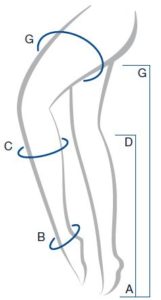
Your doctor will help you determine the size. It is better to carry out the necessary measurements in his presence, as he will be able to point out possible errors and errors in the measurements.
Important! Measurements for purchasing vein-compressive stockings for operations or childbirth must be taken after waking up in the morning.After lunch and towards evening, the legs swell (especially in expectant mothers), which significantly distorts the real data. If there is no opportunity to take measurements in the morning, then before starting the measurement you need to lie down a little, raising your legs 15-20 cm above your chest.
In this way, it is possible to ensure that the blood that has accumulated in the vessels during the day will leave, and the existing swelling will subside a little.
Measurements are taken using a measuring tape:
- thigh circumference must be measured at a point located 30 cm above the knee;
- circumference of the lower leg at its widest part;
- the circumference of the ankle at its widest point.
How to choose the correct size of compression stockings for surgery
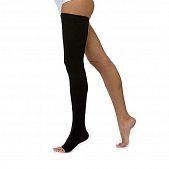
The results obtained after measurements must be compared with the size table. Based on your own indicators and those recorded in the table, you can determine your size. If any of the parameters lies on the border of two numbers, it is necessary to make a choice in favor of the larger number.
When selecting stockings for surgery, it is necessary to take into account that each manufacturer has its own size chart. Among the most popular companies, you should pay attention to the products:
- Russian company "ORTO". The stockings produced by ORTO are not highly wear-resistant and retain their therapeutic effect for no longer than four months. "ORTO" produces stockings of classes 1, 2 and 3, which can be used for prevention and rehabilitation after operations.
- "Venotex". Venotex products are in great demand among pregnant women, since their service life of 6 months is just enough for almost the entire period of bearing a child. The assortment includes summer and insulated winter models with open and closed toes.
- German company "MEDI".Made from natural and environmentally friendly materials, “MEDI” underwear is a high-quality and durable product. A wide range of models allows you to choose compression garments for each individual patient.
- "Sigvaris." The products of the Sigvaris company are an innovation in the market of medical surgical and prophylactic linen, since innovative Japanese threads are used to create them. The stockings are characterized by a high degree of comfort and cause virtually no discomfort to patients. The range of stockings from Sigvaris helps even the most inveterate fashionistas choose a pair suitable for daily wear. Fancy patterns and ornaments make them not only therapeutic, but also a stylish part of the wardrobe.
After you have purchased the underwear, you need to listen to your feelings for several days of constant wear. The following points can indicate that the size is selected correctly:
- stockings are convenient to put on, wear and take off;
- they fit tightly on the leg, without wrinkles or folds;
- stockings do not “creep” on the leg if worn all day.
Patients who have only recently been wearing compression garments need to be prepared for the fact that in the first 2-3 days they will feel discomfort from unusual compression. There is no point in drawing conclusions that the size was chosen incorrectly; the discomfort should go away after 4-5 days. If after 7-10 days the discomfort has not disappeared, you should inform your doctor, who will help you figure out the cause of the discomfort. You may have to buy a new pair, one size larger. This will have to be done, since wearing unsuitable shapewear can cause exacerbations of existing diseases.
Useful tips for choosing stockings for surgery
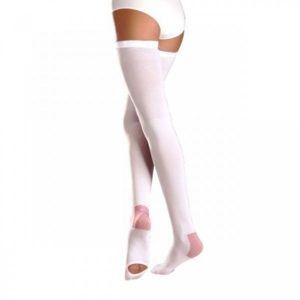
In order for wearing stockings to bring the desired effect, it is important to know how to put them on correctly, when and for how long. Operating stockings are used as follows:
- Worn several hours before surgery. It is better to do this in the morning, while there is still no swelling on the legs.
- After surgery, it is recommended not to remove it for several days.
- 2-3 days after the intervention, remove it for the night. If the operation was performed on veins, use will be around the clock. The appropriate time to remove them completely will be determined by the doctor for each patient separately.
Putting on such stockings correctly without skills is quite difficult. General recommendations:
- If there are corns or calluses on your feet, they need to be smoothed out as much as possible. You should also cut off overgrown toenails.
- Before putting on, stockings are turned inside out and gathered in the palm of your hand.
- To prevent swelling, thigh-length models are pulled on while lying down.
- The skin and the fabric itself should not be wet.
Special gloves with a ribbed surface or softening sprays can make putting them on easier. For people with disabilities, pharmacies sell special donning devices.
Due to the fact that compression stockings are quite expensive, you need to carefully care for them and be careful when wearing them. It is necessary to avoid mechanical damage and try to clean the fabric from dirt immediately after a stain has been placed on the stocking.


 1
1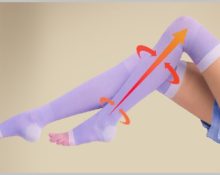
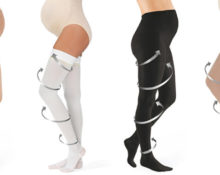

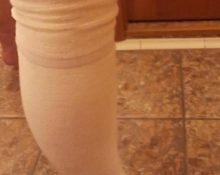
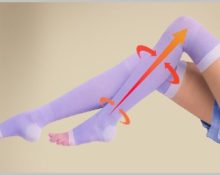


Many thanks to the author, everything is clear and simple.